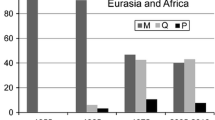Summary
The abnormal oocyte phenotype is characterized by instability, as shown by the loss and reappearance of the abo maternal effect under specific genetic conditions. Our previous finding that a correlation exists between the abo phenotype and the presence of a blood transposon in region 32E, led us to perform an extensive genetic and molecular analysis of the most significant aspects of the abo phenotype in different genetic backgrounds. The results of these experiments can be summarized as follows: Complete reversion occurs only when the blood transposon is lost, thus definitively demonstrating that the insertion of the blood transposon in region 32E is the molecular event that causes the pleiotropic abo phenotype. Partial reversion can also occur without loss of the transposon, indicating that different molecular pathways may be involved in the loss of the abo phenotype. Reappearance of the full abo phenotype can occur only in heterozygous lines constructed from partially revertant abo homozygous lines that have not lost the blood transposon.
Similar content being viewed by others
References
Graziani F, Vicari L, Boncinelli E, Malva C, Manzi A, Mariani C (1981) Selective replication of rDNA repeats after the loss of the abnormal oocyte phenotype in Drosophila melanogaster. Proc Natl Acad Sci USA 78:7662–7664
Krider HM, Levine BI (1975) Studies on the mutation abnormal oocyte and its interaction with the ribosomal DNA of Drosophila melanogaster. Genetics 81:501–513
Krider HM, Yedvobnick B, Levine BI (1979) The effect of abo phenotypic expression on ribosomal DNA instability in Drosophila melanogaster. Genetics 92:879–889
Lavorgna G, Malva C, Manzi A, Gigliotti S, Graziani F (1989) The abnormal oocyte phenotype is correlated with the presence of the blood transposon in D. melanogaster. Genetics 123:485–494
Lindsley DL, Grell EH (1968) Genetic variations of Drosophila melanogaster. Carnegie Inst Wash Publ 627
Malva C, Labella T, Manzi A, Salzano G, Lavorgna G, De Ponti L, Graziani F (1985) Maternal and zygotic interactions between the abnormal oocyte mutation and the scute 4 inversion in D. melanogaster. Genetics 111:487–494
Malva C, Graziani F, Manzi A, Cavaliere V, Tino A (1990) Genetic and molecular analysis of maternal information in region 32 of Drosophila melanogaster. Molec Repr Devl, in press
Maniatis T, Fritsch EF, Sambrook J (1982) Molecular cloning. A laboratory manual. Cold Spring Harbor Laboratory Press, New York
Manzi A, Graziani F, Labella T, Gargiulo G, Rafti F, Malva C (1986) Changes in abo phenotypic expression without increase in rDNA in D. melanogaster. Molec Gen Genet 205:366–371
Parry DM, Sandler L (1974) The genetic identification of a heterochromatic segment on the X chromosome of Drosophila melanogaster. Genetics 77:535–539
Pimpinelli S, Sullivan W, Prout M, Sandler L (1985) On biological functions mapping to the heterochromatin on Drosophila melanogaster. Genetics 109:701–724
Rigby PWJ, Dieckman M, Rhodes C, Berg P (1977) Labeling deoxyribonucleic acid to high specific activity in vitro by nick translation with DNA polymerase I. J Mol Biol 113:237–251
Sandler L (1970) The regulation of sex-chromosome heterochromatic activity by an autosomal gene in Drosophila melanogaster. Genetics 64:481–493
Sandler L (1975) Studies on the genetic control of heterochromatin in Drosophila melanogaster. Isr J Med Sci 11:1124–1134
Sandler L, Lindsley DL, Nicoletti B, Trippa G (1968) Mutants affecting meiosis in natural populations of Drosophila melanogaster. Genetics 60:525–558
Southern E (1975) Detection of specific sequences among DNA fragments separated by gel electrophoresis. J Mol Biol 98:503–519
Sullivan W, Pimpinelli S (1986) The genetic factors altered in homozygous abo stocks of Drosophila melanogaster. Genetics 114:885
Yedvobnick B, Krider HM, Levine BI (1980) Analysis of the autosomal mutation abo and its interaction with the ribosomal DNA of Drosophila melanogaster: the role of X-chromosome heterochromatin. Genetics 95:661–672
Author information
Authors and Affiliations
Additional information
Communicated by J.A. Campos-Ortega
Rights and permissions
About this article
Cite this article
Cavaliere, V., Graziani, F., Andone, S. et al. Complete reversion of the abo phenotype in D. melanogaster occurs only when the blood transposon is lost from region 32E. Molec. Gen. Genet. 230, 433–441 (1991). https://doi.org/10.1007/BF00280300
Received:
Issue Date:
DOI: https://doi.org/10.1007/BF00280300




